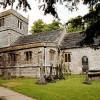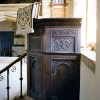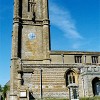I made my first visit to Powerstock on the first Saturday in June 2006. It was the first real summer’s day we enjoyed here in Dorset that year and just the right time to get away from the county town and visit a country church. I recall three ladies were sharing a bench and the shade from an overhanging tree while their husbands were laid out on the grass soaking up the sun and staring at the wisps of cloud suspended in an otherwise clear blue sky. I returned to the parish on the first Saturday in June this year and again I was blessed with a fine sunny day.
The church, dedicated to St. Mary, sits in a commanding position at the centre of the village above the junction where four lanes meet. The village is small but by Dorset standards Powerstock is a large parish that takes in the hamlets of West Milton, Wytherstone and Nettlecombe.
In the second-half of the 19th century our Victorian ancestors were busy restoring churches all over the country; in Dorset it is difficult to find churches they didn’t work on, sometimes tampering and meddling unnecessarily. St Mary’s at Powerstock didn’t escape their attentions but here the restoration was justified to remedy a dilapidated structure that was too small to accommodate a growing congregation.
No sooner was Thomas Sanctuary installed as vicar of Powerstock than he determined to have better education for children of the poor and better church accommodation. Work on the church started in 1854, under his supervision, and took five years to complete. Sanctuary was vicar here from 1848 to 1889 and his wife is thought to have designed and painted the holly and ivy decoration on the walls in the nave.
During Sanctuary’s time as vicar some of the most distinguished prelates of the 19th century came to Powerstock including Wilberforce, Bishop of Oxford and Winchester, and Dr. Magee, Bishop of Peterborough; also Dr. Fraser, Bishop of Manchester and Dr. Wordsworth, Bishop of Lincoln.
St. Mary’s dates from the middle of the 12th century and consists of chancel, nave and west tower. Aisles were added to the nave in the 14th century when alterations were made to the tower, which was altered again and heightened a century later. The 1850’s saw the north aisle and arcade added but both retain 14th century features. The south aisle and porch are modern.
The chancel was completely rebuilt during the 1850’s improvements, except for the magnificent mid 12th century chancel arch, of which Pevsner tells us “is the most elaborate Norman chancel arch in any Dorset parish church.” The arch is lop-sided, leaning to the south a result of work done in the 14th century when two hagioscopes or squints were made in the wall south of the arch. During the 1850’s makeover two galleries were removed from the west and south sides.
The partly restored 14th century north arcade of three bays and two-centred arches is generally similar in date and detail to the south arcade. The north aisle, said to have been rebuilt in 1858, incorporates four 14th century windows each with two lights – one in the east wall and three in the north wall.
The south aisle is part of the 1850’s expansion and restoration and incorporates a 15th century doorway into the south porch, which has been described by one expert as “a rich work of great merit which would suffice alone to give the fabric very special distinction.” The windows in the south aisle are modern. The 13th century font was reinstated in 1972 having for a time been removed to the churchyard. Special mention should be given to the baptistery window in the west wall. Known as The Sanctuary Window it was designed by Thomas Denny and dedicated at a service on 17th of October 1991. It was presented by the widow of Mark Stapleton Sanctuary. The late Saxon or Early Norman piscina in the chancel was found on a farm not far away in 1925; a vestige of the original building – around its base there is a cable mould similar to the chancel arch.
The west tower is of three stages with an embattled parapet and the arch leading into the tower was opened up during Thomas Sanctuary’s improvements. The west doorway dates from the 14th century. The bell-chamber has, in each wall, an early 15th century window of two lights and is home to six bells: five; 1st, 3rd and 5th are by Thomas Bilbie of Cullompton and are dated 1772; 2nd is by Thomas Purdue and dated 1712. The number 4 tenor bell bears the initials T.P (probably Thomas Purdue) and date 1684. This bell was recast in 1897 when the bells were re-hung to mark Queen Victoria’s Diamond Jubilee. The sixth bell is a recent addition; hung in 1960 in memory of Mr William Sykes.
There are memorial plaques to Thomas Larcombe, churchwarden, 1610; Montague Rush, a former vicar at Powerstock who died in 1821 and one to Thomas Russell who died in 1788. In the churchyard the graves of Thomas Burt 1747; James Burt 1774 and Mary his wife 1784; Thomas Burt 1749 and his wife Elizabeth 1751; William Travis 1646, and another William Travis 1682 and Joan Travis 1717; Richard Sanders 1706; Ester Syms 1701; Henry Smith Snr., 1706; Rebekah, wife of John Mitchell 1712.
For four decades the village of Powerstock was home to Admiral Sir Victor Crutchley VC: he died aged 92 in 1986 at his home at Nettlecombe and is buried in the churchyard beneath a wooden cross with the “For Valour” insignia of the Victoria Cross.



